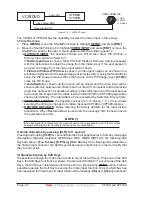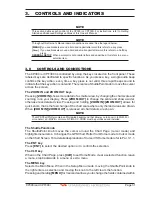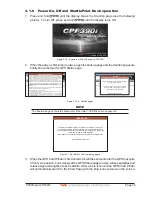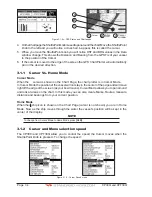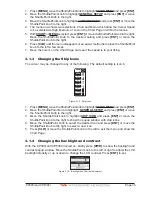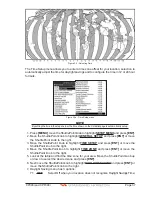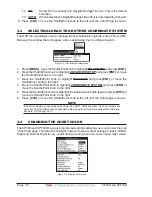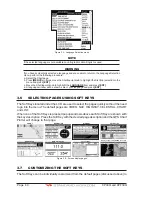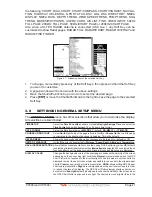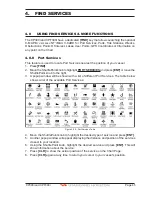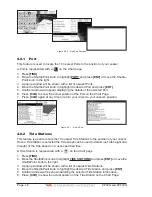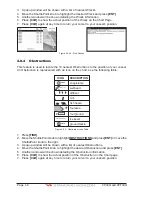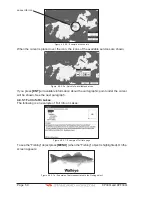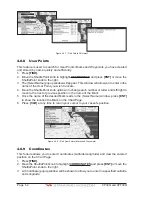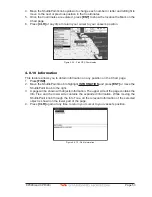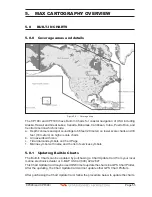
CP390i and CPF390i
Page 41
the following: CHART, DUAL CHART, CHART/COMPASS, CHART/HIGHWAY, NAVIGA-
TION, HIGHWAY, CELESTIAL, GPS STATUS, DSC LOG, DSC DIRECTORY, NMEA
DISPLAY, NMEA DATA, DEPTH TREND, WIND SPEED TREND, TEMP TREND, SOG
TREND, MARKS/WAYPOINTS, USER C-CARD, AIS LIST, FIND, VIDEO INPUT, 50kHz
FULL PAGE, 200kHz FULL PAGE, 50kHz/CHART PAGE or 200kHz/CHART PAGE.
Also when a SI-TEX RADAR antenna is connected (USA O
NLY
), any Soft Key can be
customized to show Radar pages, RADAR FULL, RADAR/CHART, RADAR OVERLAY and
RADAR/FISH FINDER.
WAAS 3D
AIS LIST
Figure 3.7 - Window options of the selected Soft Key
1. To change, momentarily press any of the Soft Keys, then press and hold the Soft Key
you want to customize.
2. A popup window will be shown with the above settings.
3. Move the ShuttlePoint knob up or down to select the desired page.
4. Press
[ENT]
or move the ShuttlePoint knob to the right to save the page to the selected
Soft Key.
3.8
SETTINGS IN GENERAL SETUP MENU
The
GENERAL SETUP
menu has other selections that allow you to customize the display.
All selections are listed below:
TIME SETUP
Select the
Time Zone offset
, enable or disable
Daylight Savings Time
and select the
Time Format
and switch between 12 or 24 hours time format.
DATE FORMAT
Select the Date format among
MM-DD-YY
(default),
DD-MM-YY
or
YY-MM-DD
.
COURSE UP/NORTH UP
Select
North Up
(the top of the page is fixed to North) or
Course Up
(the top of the page
is orientated to the direction the vessel is heading. This is the default).
KEYPAD BEEP
Allows the beep produced when a key is pressed to be turned On (default) or Off.
UNITS OF MEASURE
Units of Measure can be selected for
Distance*
,
Speed
,
Depth
,
Altitude
and
Temperature
.
NAV AIDS PRESENTATION
Allows the Nav Aids presentation to be drawn using NOAA symbology when
US
(default)
is selected or International symbols when
International
is selected. When selected these
functions affect how the icons for Lights, Signals, Buoys and Beacons are displayed.
DISPLAY COLOR
Changes the background colors of the chart page to enhance the visibility of the screen
depending on the surrounding light conditions.
Normal
is recommended when the GPS
Chart Plotter is not exposed to the direct sunlight. When this mode is set the charts are
displayed in order to use colors as similar as possible to ones used in the original paper
charts.
Classic
uses vivid chart colors presentation.
NOAA
allows setting NOAA paper
chart colors presentation.
Night
is recommended when the environment is dark in order
to reduce the glare of the display. The GPS Chart Plotter displays charts and screen in
darker colors.
SunLight
(default) is designed to enhance the visibility of the screen when
the GPS Chart Plotter is exposed to sunlight. The charts are much brighter than in the
Summary of Contents for CP390i
Page 1: ......
Page 5: ...Page 6 CP390i and CPF390i ...
Page 15: ...Page 16 CP390i and CPF390i ...
Page 29: ...Page 30 CP390i and CPF390i ...
Page 43: ...Page 44 CP390i and CPF390i ...
Page 53: ...Page 54 CP390i and CPF390i ...
Page 67: ...Page 68 CP390i and CPF390i ...
Page 75: ...Page 76 CP390i and CPF390i ...
Page 83: ...Page 84 CP390i and CPF390i ...
Page 87: ...Page 88 CP390i and CPF390i ...
Page 109: ...Page 110 CP390i and CPF390i ...
Page 145: ...Page 146 CP390i and CPF390i Figure 17 16 C Card Restore settings ...
Page 147: ...Page 148 CP390i and CPF390i ...
Page 153: ...Page 154 CP390i and CPF390i ...
Page 157: ...Page 158 CP390i and CPF390i ...
Page 168: ......


